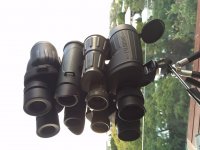Rathaus
Well-known member
Just a very brief test...totally subjective...my eyeballs on this day. A specific test, most likely unrelated to the so so many other positive attributes of good binoculars.
So...This afternoon for a bit of fun I gathered together a few of my favourite binos for an on axis resolution shoutout at sunset then leading into early evening.
Fujinon fmtr-sx 7x50
Swarovski 8.5x42 SV
Canon 10x42 is L
Swarovski Habicht 10x40 GA
Oddly, I left out a couple of late model Habicht 8x30 which sat in a drawer instead. I've tested them with these before however so I know of their prowess.
As a platform I used my trusty junk shop mini tripod with the big grippy rubber fujis attached. Perfect!
I'm in an elevated spot but have a few subjects which I can especially focus on to test resolution. The tip of a tall pine tree 250M away..counting and resolving the new sprouts on its tiny tip.
The nasty test however is a 12-24 inch tall thin 'hypodermic' like lightening rod atop a spire atop a 60 or so story building exactly 5 km away. This thing is nasty to resolve. A cruel test. At certain times of day it is just impossible to see being so thin. Seeing it after sunset is a challenging task.
I acknowledge the varying magnifications, but everything is mounted...and to my eyes some stated magnifications are not what they seem.
So which binos could see this hypodermic rod latest into the evening?
-The winner today is the Habicht 10x40. It resolved beyond the others.
-The 8.5x42 SV in second place. Superb.
- The Fuji 7x50 was so close to the 8.5 SV it was astonishing for just 7x...and considering I was using the same focus setting as 50m away..astonishing.
-The Canon 10x42 were a great disappointment tonight. One of the most ruthlessly resolving binocular I have ever previously encountered wasn't up to the challenge. It was markedly better with IS Off but mounted. It was still very good. I'm wondering what's going on here. All my binos are in otherwise perfect condition. I'm concerned about my fat, heavy, fragile Cannons.
My iPad is running at 2% battery so bye for now...will update later regarding perceived brightness...something I also jotted down.
So...This afternoon for a bit of fun I gathered together a few of my favourite binos for an on axis resolution shoutout at sunset then leading into early evening.
Fujinon fmtr-sx 7x50
Swarovski 8.5x42 SV
Canon 10x42 is L
Swarovski Habicht 10x40 GA
Oddly, I left out a couple of late model Habicht 8x30 which sat in a drawer instead. I've tested them with these before however so I know of their prowess.
As a platform I used my trusty junk shop mini tripod with the big grippy rubber fujis attached. Perfect!
I'm in an elevated spot but have a few subjects which I can especially focus on to test resolution. The tip of a tall pine tree 250M away..counting and resolving the new sprouts on its tiny tip.
The nasty test however is a 12-24 inch tall thin 'hypodermic' like lightening rod atop a spire atop a 60 or so story building exactly 5 km away. This thing is nasty to resolve. A cruel test. At certain times of day it is just impossible to see being so thin. Seeing it after sunset is a challenging task.
I acknowledge the varying magnifications, but everything is mounted...and to my eyes some stated magnifications are not what they seem.
So which binos could see this hypodermic rod latest into the evening?
-The winner today is the Habicht 10x40. It resolved beyond the others.
-The 8.5x42 SV in second place. Superb.
- The Fuji 7x50 was so close to the 8.5 SV it was astonishing for just 7x...and considering I was using the same focus setting as 50m away..astonishing.
-The Canon 10x42 were a great disappointment tonight. One of the most ruthlessly resolving binocular I have ever previously encountered wasn't up to the challenge. It was markedly better with IS Off but mounted. It was still very good. I'm wondering what's going on here. All my binos are in otherwise perfect condition. I'm concerned about my fat, heavy, fragile Cannons.
My iPad is running at 2% battery so bye for now...will update later regarding perceived brightness...something I also jotted down.
Attachments
Last edited:




